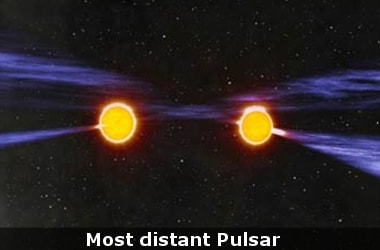
The pulsar is 50 million light years away.
It's a collapsed star spinning around at an increasing speed and sending out as much energy in one second as the Sun does in 3.5 years.
The discovery was made by scientists using the x-ray observatory space craft XMM-Newton managed by the European Space Agency (ESA).
The newly found pulsar is a 1000 times brighter than previously thought possible and also the most distant of its kind ever detected.
It completes one rotation in just over a second.
The discovery of this very unusual object, by far the most extreme ever discovered in terms of distance, luminosity and rate of increase of its rotation frequency, sets a new record for XMM-Newton, and is changing our ideas of how such objects really function.
XMM-Newton observed the object several times in the last 13 years, with the discovery a result of a systematic search for pulsars in the data archive–its 1.13 s periodic pulses giving it away.
The signal was also identified in NASA's Nustar archive data, providing additional information.
Previously, it was held only black holes at least 10 times more massive than our sun feeding off their stellar companions could achieve such extraordinary luminosities, but the rapid and regular pulsations of this source are the fingerprints of neutron stars and clearly distinguish them from black holes, according to scientists.
Only a neutron star is compact enough to keep itself together while rotating so fast.
The scientists think there must be a strong, complex magnetic field close to its surface, such that accretion onto the neutron star surface is still possible while still generating the high luminosity.
What are Pulsars?- Pulsars are spinning, magnetised neutron stars that sweep regular pulses of radiation in two symmetrical beams across the cosmos.
- If suitably aligned with Earth these beams are like a lighthouse beacon appearing to flash on and off as it rotates.
- They were once massive stars that exploded as a powerful supernova at the end of their natural life. They small and extraordinarily dense stellar corpses.